The Increasing Quest for Organic Foods in Hospitality and Gastronomy
VerifiedAdded on 2020/05/28
|6
|1492
|134
AI Summary
The research essay delves into the rising trend of organic food preferences in the hospitality industry, influenced by growing health awareness and cultural factors. It discusses how consumer attitudes towards nutrition are reshaping dining habits globally, with a focus on natural ingredients and simpler preparation methods. The essay highlights Asian culinary arts' impact on this shift and explores market challenges faced by global players like McDonald's. Despite concerns over cost, the demand for healthier food options continues to grow, supported by research advocating nutritional benefits. Future discussions are encouraged across industries to address these evolving consumer preferences.
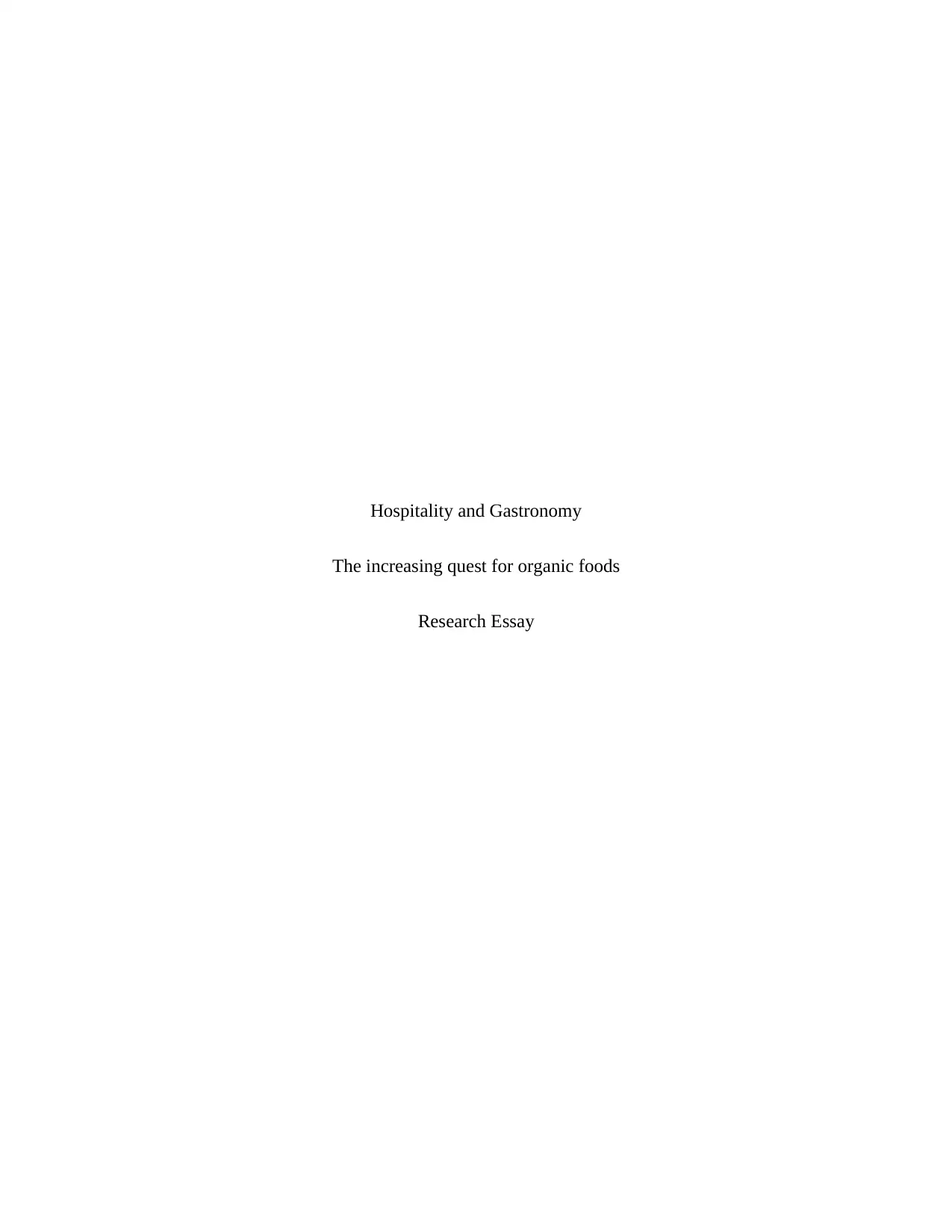
Hospitality and Gastronomy
The increasing quest for organic foods
Research Essay
The increasing quest for organic foods
Research Essay
Paraphrase This Document
Need a fresh take? Get an instant paraphrase of this document with our AI Paraphraser
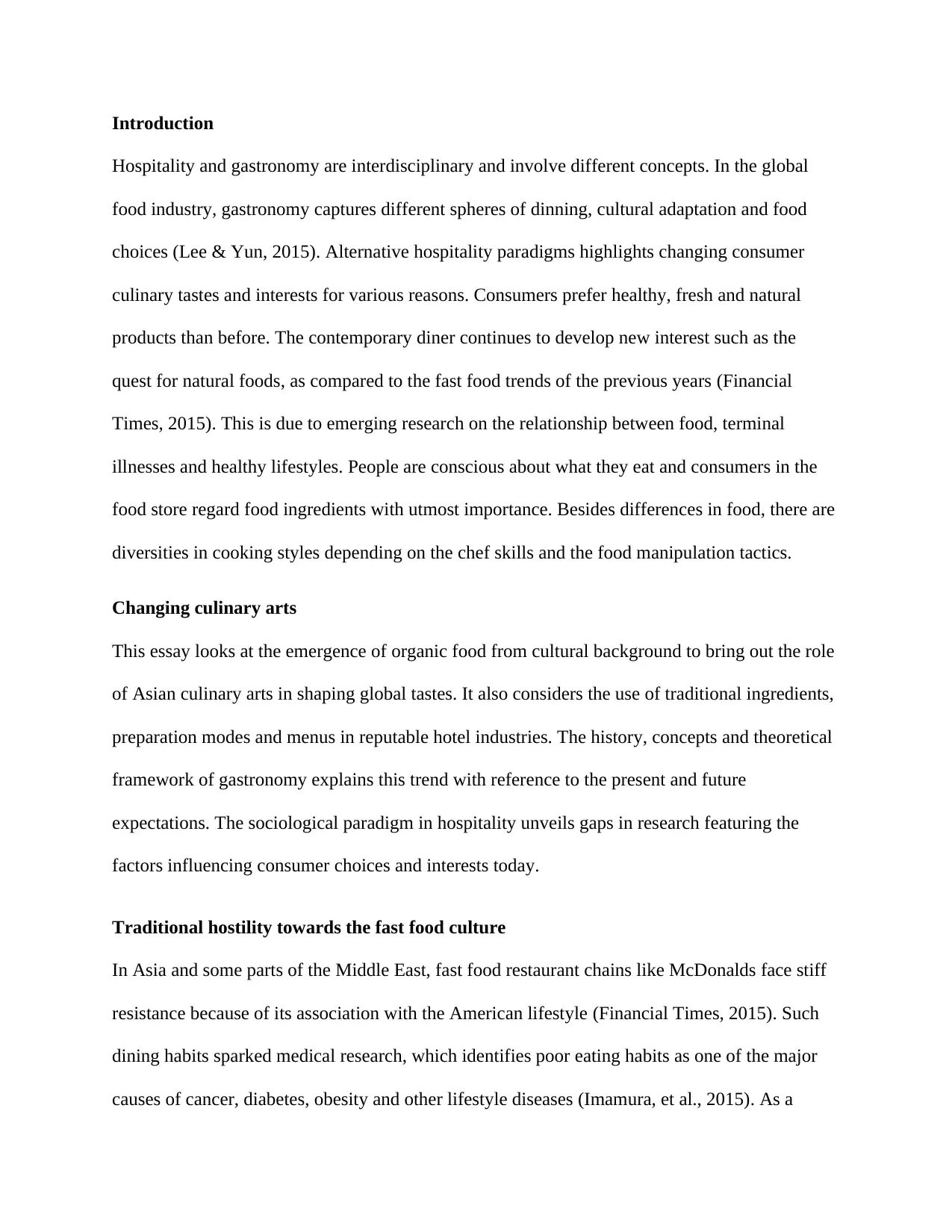
Introduction
Hospitality and gastronomy are interdisciplinary and involve different concepts. In the global
food industry, gastronomy captures different spheres of dinning, cultural adaptation and food
choices (Lee & Yun, 2015). Alternative hospitality paradigms highlights changing consumer
culinary tastes and interests for various reasons. Consumers prefer healthy, fresh and natural
products than before. The contemporary diner continues to develop new interest such as the
quest for natural foods, as compared to the fast food trends of the previous years (Financial
Times, 2015). This is due to emerging research on the relationship between food, terminal
illnesses and healthy lifestyles. People are conscious about what they eat and consumers in the
food store regard food ingredients with utmost importance. Besides differences in food, there are
diversities in cooking styles depending on the chef skills and the food manipulation tactics.
Changing culinary arts
This essay looks at the emergence of organic food from cultural background to bring out the role
of Asian culinary arts in shaping global tastes. It also considers the use of traditional ingredients,
preparation modes and menus in reputable hotel industries. The history, concepts and theoretical
framework of gastronomy explains this trend with reference to the present and future
expectations. The sociological paradigm in hospitality unveils gaps in research featuring the
factors influencing consumer choices and interests today.
Traditional hostility towards the fast food culture
In Asia and some parts of the Middle East, fast food restaurant chains like McDonalds face stiff
resistance because of its association with the American lifestyle (Financial Times, 2015). Such
dining habits sparked medical research, which identifies poor eating habits as one of the major
causes of cancer, diabetes, obesity and other lifestyle diseases (Imamura, et al., 2015). As a
Hospitality and gastronomy are interdisciplinary and involve different concepts. In the global
food industry, gastronomy captures different spheres of dinning, cultural adaptation and food
choices (Lee & Yun, 2015). Alternative hospitality paradigms highlights changing consumer
culinary tastes and interests for various reasons. Consumers prefer healthy, fresh and natural
products than before. The contemporary diner continues to develop new interest such as the
quest for natural foods, as compared to the fast food trends of the previous years (Financial
Times, 2015). This is due to emerging research on the relationship between food, terminal
illnesses and healthy lifestyles. People are conscious about what they eat and consumers in the
food store regard food ingredients with utmost importance. Besides differences in food, there are
diversities in cooking styles depending on the chef skills and the food manipulation tactics.
Changing culinary arts
This essay looks at the emergence of organic food from cultural background to bring out the role
of Asian culinary arts in shaping global tastes. It also considers the use of traditional ingredients,
preparation modes and menus in reputable hotel industries. The history, concepts and theoretical
framework of gastronomy explains this trend with reference to the present and future
expectations. The sociological paradigm in hospitality unveils gaps in research featuring the
factors influencing consumer choices and interests today.
Traditional hostility towards the fast food culture
In Asia and some parts of the Middle East, fast food restaurant chains like McDonalds face stiff
resistance because of its association with the American lifestyle (Financial Times, 2015). Such
dining habits sparked medical research, which identifies poor eating habits as one of the major
causes of cancer, diabetes, obesity and other lifestyle diseases (Imamura, et al., 2015). As a
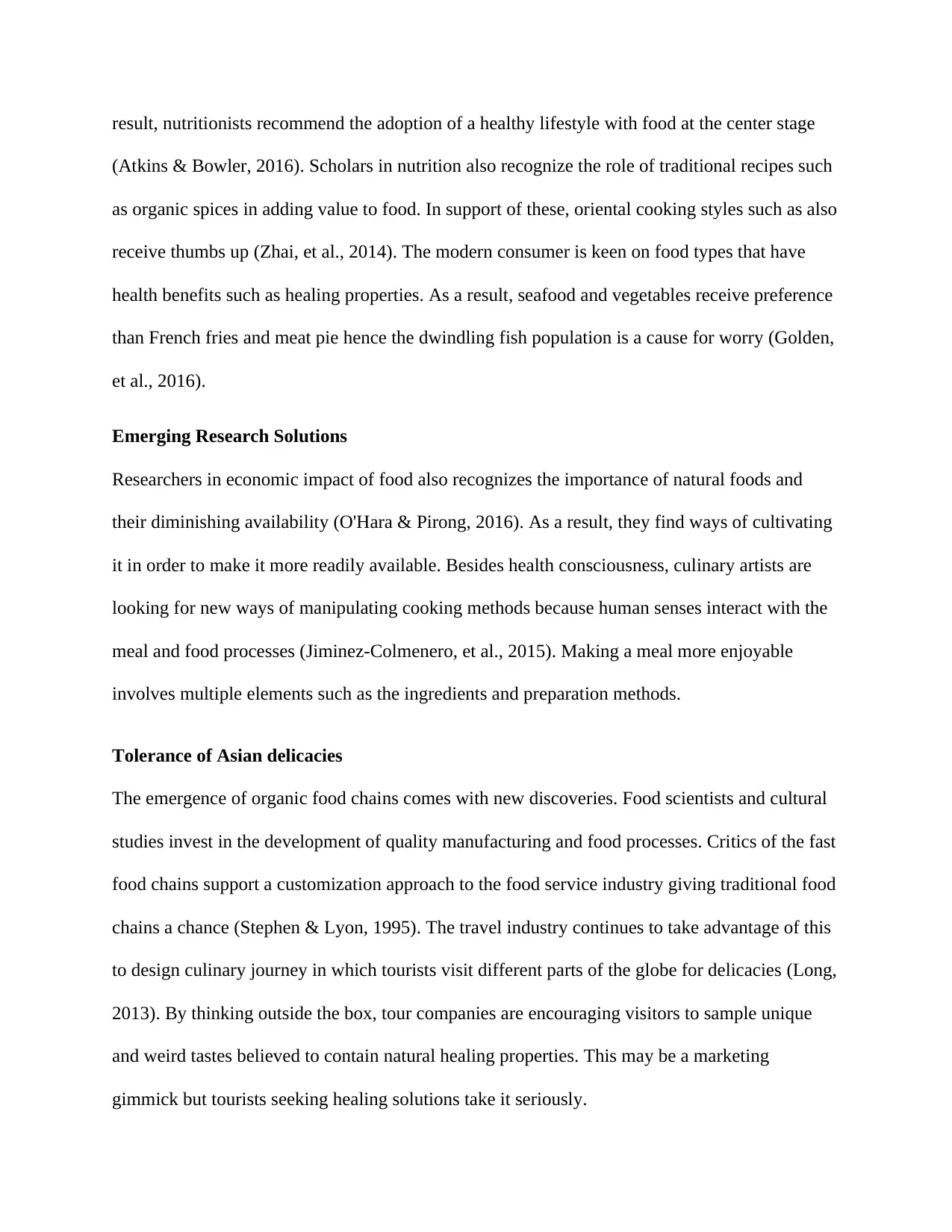
result, nutritionists recommend the adoption of a healthy lifestyle with food at the center stage
(Atkins & Bowler, 2016). Scholars in nutrition also recognize the role of traditional recipes such
as organic spices in adding value to food. In support of these, oriental cooking styles such as also
receive thumbs up (Zhai, et al., 2014). The modern consumer is keen on food types that have
health benefits such as healing properties. As a result, seafood and vegetables receive preference
than French fries and meat pie hence the dwindling fish population is a cause for worry (Golden,
et al., 2016).
Emerging Research Solutions
Researchers in economic impact of food also recognizes the importance of natural foods and
their diminishing availability (O'Hara & Pirong, 2016). As a result, they find ways of cultivating
it in order to make it more readily available. Besides health consciousness, culinary artists are
looking for new ways of manipulating cooking methods because human senses interact with the
meal and food processes (Jiminez-Colmenero, et al., 2015). Making a meal more enjoyable
involves multiple elements such as the ingredients and preparation methods.
Tolerance of Asian delicacies
The emergence of organic food chains comes with new discoveries. Food scientists and cultural
studies invest in the development of quality manufacturing and food processes. Critics of the fast
food chains support a customization approach to the food service industry giving traditional food
chains a chance (Stephen & Lyon, 1995). The travel industry continues to take advantage of this
to design culinary journey in which tourists visit different parts of the globe for delicacies (Long,
2013). By thinking outside the box, tour companies are encouraging visitors to sample unique
and weird tastes believed to contain natural healing properties. This may be a marketing
gimmick but tourists seeking healing solutions take it seriously.
(Atkins & Bowler, 2016). Scholars in nutrition also recognize the role of traditional recipes such
as organic spices in adding value to food. In support of these, oriental cooking styles such as also
receive thumbs up (Zhai, et al., 2014). The modern consumer is keen on food types that have
health benefits such as healing properties. As a result, seafood and vegetables receive preference
than French fries and meat pie hence the dwindling fish population is a cause for worry (Golden,
et al., 2016).
Emerging Research Solutions
Researchers in economic impact of food also recognizes the importance of natural foods and
their diminishing availability (O'Hara & Pirong, 2016). As a result, they find ways of cultivating
it in order to make it more readily available. Besides health consciousness, culinary artists are
looking for new ways of manipulating cooking methods because human senses interact with the
meal and food processes (Jiminez-Colmenero, et al., 2015). Making a meal more enjoyable
involves multiple elements such as the ingredients and preparation methods.
Tolerance of Asian delicacies
The emergence of organic food chains comes with new discoveries. Food scientists and cultural
studies invest in the development of quality manufacturing and food processes. Critics of the fast
food chains support a customization approach to the food service industry giving traditional food
chains a chance (Stephen & Lyon, 1995). The travel industry continues to take advantage of this
to design culinary journey in which tourists visit different parts of the globe for delicacies (Long,
2013). By thinking outside the box, tour companies are encouraging visitors to sample unique
and weird tastes believed to contain natural healing properties. This may be a marketing
gimmick but tourists seeking healing solutions take it seriously.
⊘ This is a preview!⊘
Do you want full access?
Subscribe today to unlock all pages.

Trusted by 1+ million students worldwide
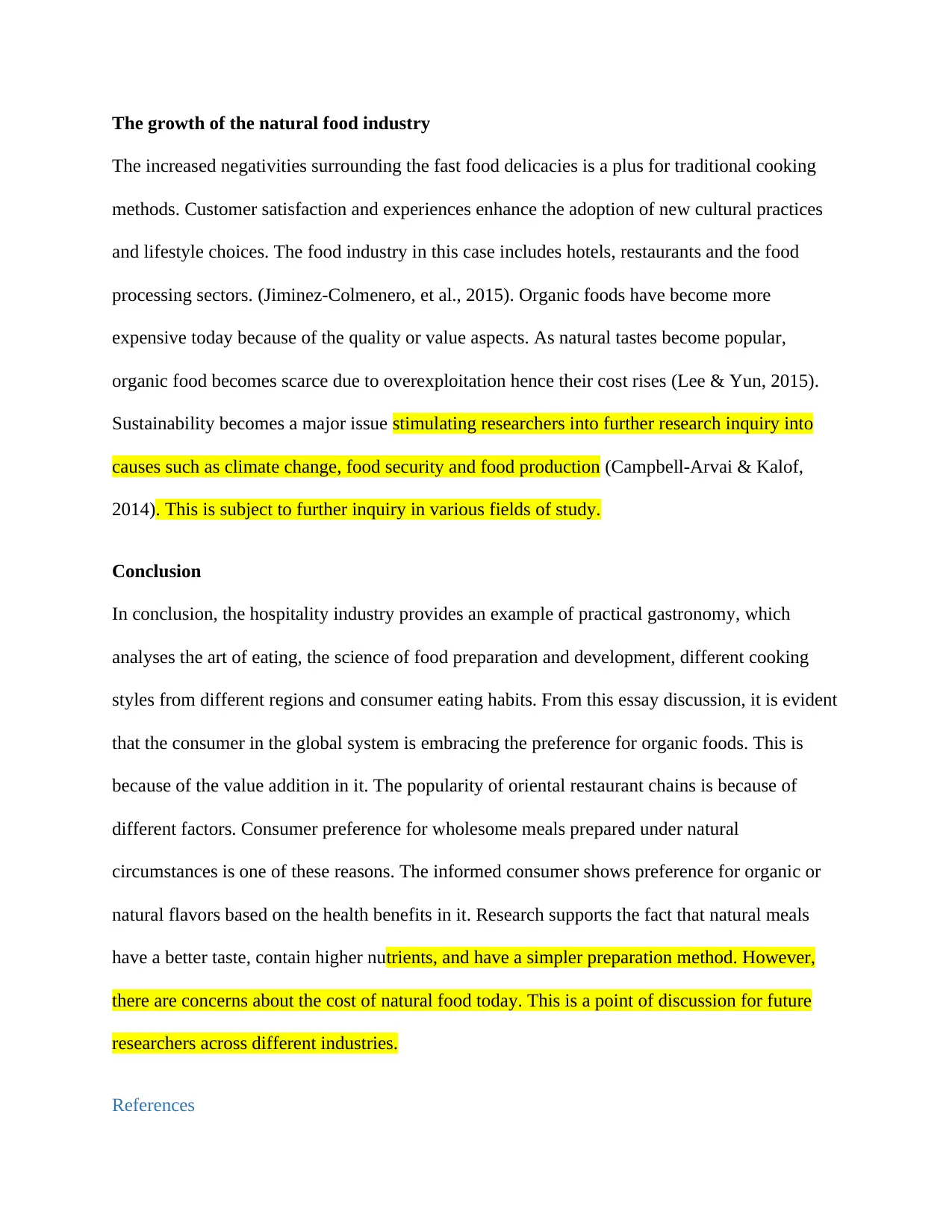
The growth of the natural food industry
The increased negativities surrounding the fast food delicacies is a plus for traditional cooking
methods. Customer satisfaction and experiences enhance the adoption of new cultural practices
and lifestyle choices. The food industry in this case includes hotels, restaurants and the food
processing sectors. (Jiminez-Colmenero, et al., 2015). Organic foods have become more
expensive today because of the quality or value aspects. As natural tastes become popular,
organic food becomes scarce due to overexploitation hence their cost rises (Lee & Yun, 2015).
Sustainability becomes a major issue stimulating researchers into further research inquiry into
causes such as climate change, food security and food production (Campbell-Arvai & Kalof,
2014). This is subject to further inquiry in various fields of study.
Conclusion
In conclusion, the hospitality industry provides an example of practical gastronomy, which
analyses the art of eating, the science of food preparation and development, different cooking
styles from different regions and consumer eating habits. From this essay discussion, it is evident
that the consumer in the global system is embracing the preference for organic foods. This is
because of the value addition in it. The popularity of oriental restaurant chains is because of
different factors. Consumer preference for wholesome meals prepared under natural
circumstances is one of these reasons. The informed consumer shows preference for organic or
natural flavors based on the health benefits in it. Research supports the fact that natural meals
have a better taste, contain higher nutrients, and have a simpler preparation method. However,
there are concerns about the cost of natural food today. This is a point of discussion for future
researchers across different industries.
References
The increased negativities surrounding the fast food delicacies is a plus for traditional cooking
methods. Customer satisfaction and experiences enhance the adoption of new cultural practices
and lifestyle choices. The food industry in this case includes hotels, restaurants and the food
processing sectors. (Jiminez-Colmenero, et al., 2015). Organic foods have become more
expensive today because of the quality or value aspects. As natural tastes become popular,
organic food becomes scarce due to overexploitation hence their cost rises (Lee & Yun, 2015).
Sustainability becomes a major issue stimulating researchers into further research inquiry into
causes such as climate change, food security and food production (Campbell-Arvai & Kalof,
2014). This is subject to further inquiry in various fields of study.
Conclusion
In conclusion, the hospitality industry provides an example of practical gastronomy, which
analyses the art of eating, the science of food preparation and development, different cooking
styles from different regions and consumer eating habits. From this essay discussion, it is evident
that the consumer in the global system is embracing the preference for organic foods. This is
because of the value addition in it. The popularity of oriental restaurant chains is because of
different factors. Consumer preference for wholesome meals prepared under natural
circumstances is one of these reasons. The informed consumer shows preference for organic or
natural flavors based on the health benefits in it. Research supports the fact that natural meals
have a better taste, contain higher nutrients, and have a simpler preparation method. However,
there are concerns about the cost of natural food today. This is a point of discussion for future
researchers across different industries.
References
Paraphrase This Document
Need a fresh take? Get an instant paraphrase of this document with our AI Paraphraser
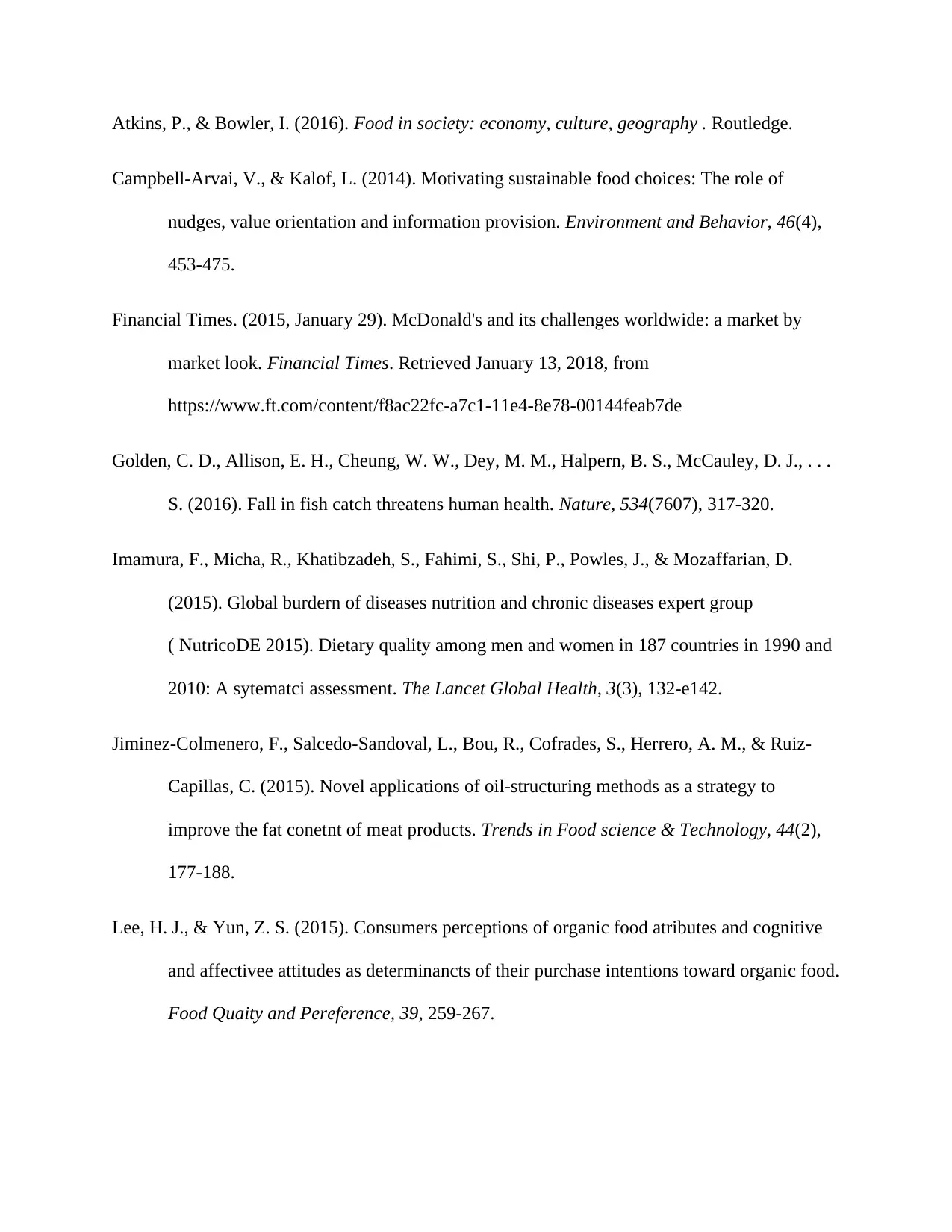
Atkins, P., & Bowler, I. (2016). Food in society: economy, culture, geography . Routledge.
Campbell-Arvai, V., & Kalof, L. (2014). Motivating sustainable food choices: The role of
nudges, value orientation and information provision. Environment and Behavior, 46(4),
453-475.
Financial Times. (2015, January 29). McDonald's and its challenges worldwide: a market by
market look. Financial Times. Retrieved January 13, 2018, from
https://www.ft.com/content/f8ac22fc-a7c1-11e4-8e78-00144feab7de
Golden, C. D., Allison, E. H., Cheung, W. W., Dey, M. M., Halpern, B. S., McCauley, D. J., . . .
S. (2016). Fall in fish catch threatens human health. Nature, 534(7607), 317-320.
Imamura, F., Micha, R., Khatibzadeh, S., Fahimi, S., Shi, P., Powles, J., & Mozaffarian, D.
(2015). Global burdern of diseases nutrition and chronic diseases expert group
( NutricoDE 2015). Dietary quality among men and women in 187 countries in 1990 and
2010: A sytematci assessment. The Lancet Global Health, 3(3), 132-e142.
Jiminez-Colmenero, F., Salcedo-Sandoval, L., Bou, R., Cofrades, S., Herrero, A. M., & Ruiz-
Capillas, C. (2015). Novel applications of oil-structuring methods as a strategy to
improve the fat conetnt of meat products. Trends in Food science & Technology, 44(2),
177-188.
Lee, H. J., & Yun, Z. S. (2015). Consumers perceptions of organic food atributes and cognitive
and affectivee attitudes as determinancts of their purchase intentions toward organic food.
Food Quaity and Pereference, 39, 259-267.
Campbell-Arvai, V., & Kalof, L. (2014). Motivating sustainable food choices: The role of
nudges, value orientation and information provision. Environment and Behavior, 46(4),
453-475.
Financial Times. (2015, January 29). McDonald's and its challenges worldwide: a market by
market look. Financial Times. Retrieved January 13, 2018, from
https://www.ft.com/content/f8ac22fc-a7c1-11e4-8e78-00144feab7de
Golden, C. D., Allison, E. H., Cheung, W. W., Dey, M. M., Halpern, B. S., McCauley, D. J., . . .
S. (2016). Fall in fish catch threatens human health. Nature, 534(7607), 317-320.
Imamura, F., Micha, R., Khatibzadeh, S., Fahimi, S., Shi, P., Powles, J., & Mozaffarian, D.
(2015). Global burdern of diseases nutrition and chronic diseases expert group
( NutricoDE 2015). Dietary quality among men and women in 187 countries in 1990 and
2010: A sytematci assessment. The Lancet Global Health, 3(3), 132-e142.
Jiminez-Colmenero, F., Salcedo-Sandoval, L., Bou, R., Cofrades, S., Herrero, A. M., & Ruiz-
Capillas, C. (2015). Novel applications of oil-structuring methods as a strategy to
improve the fat conetnt of meat products. Trends in Food science & Technology, 44(2),
177-188.
Lee, H. J., & Yun, Z. S. (2015). Consumers perceptions of organic food atributes and cognitive
and affectivee attitudes as determinancts of their purchase intentions toward organic food.
Food Quaity and Pereference, 39, 259-267.
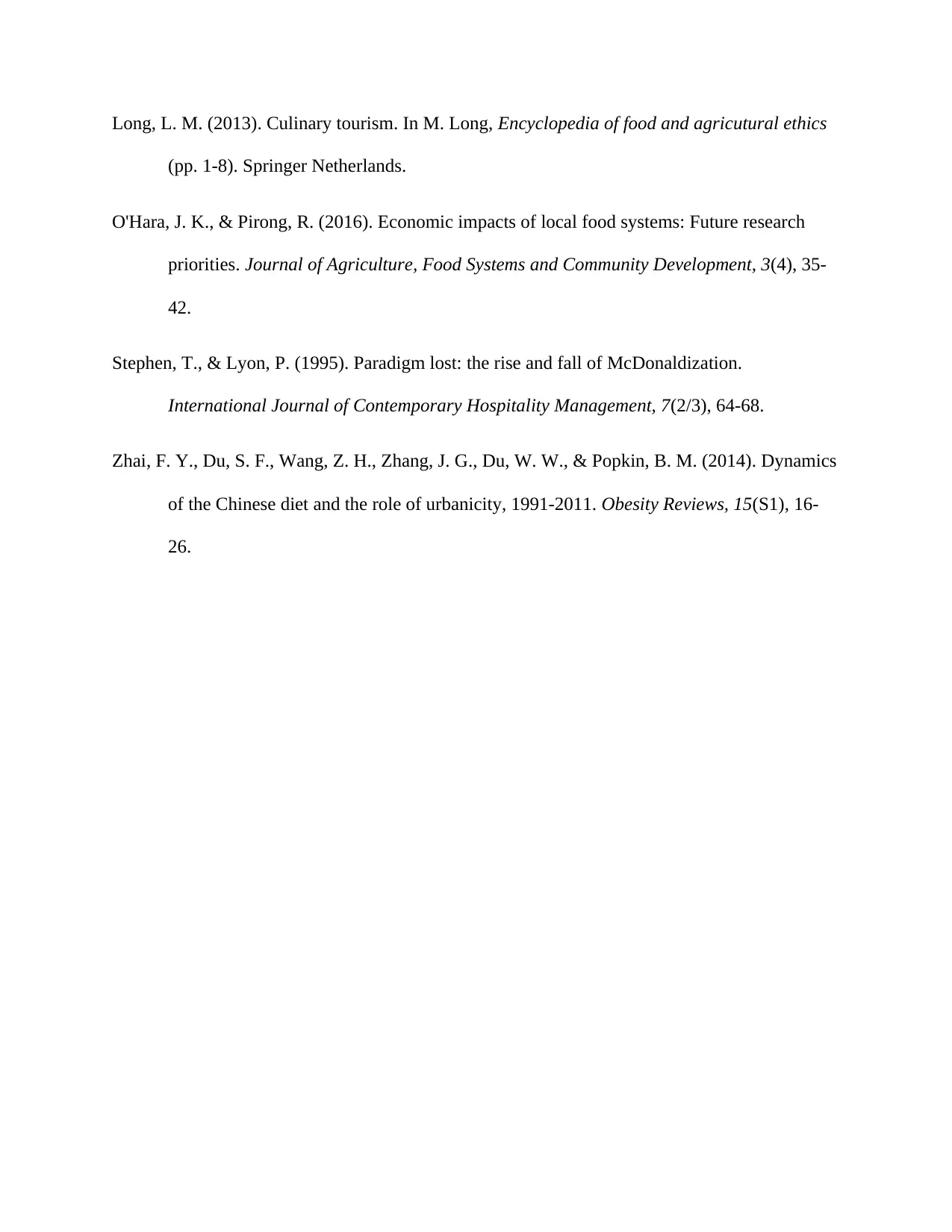
Long, L. M. (2013). Culinary tourism. In M. Long, Encyclopedia of food and agricutural ethics
(pp. 1-8). Springer Netherlands.
O'Hara, J. K., & Pirong, R. (2016). Economic impacts of local food systems: Future research
priorities. Journal of Agriculture, Food Systems and Community Development, 3(4), 35-
42.
Stephen, T., & Lyon, P. (1995). Paradigm lost: the rise and fall of McDonaldization.
International Journal of Contemporary Hospitality Management, 7(2/3), 64-68.
Zhai, F. Y., Du, S. F., Wang, Z. H., Zhang, J. G., Du, W. W., & Popkin, B. M. (2014). Dynamics
of the Chinese diet and the role of urbanicity, 1991-2011. Obesity Reviews, 15(S1), 16-
26.
(pp. 1-8). Springer Netherlands.
O'Hara, J. K., & Pirong, R. (2016). Economic impacts of local food systems: Future research
priorities. Journal of Agriculture, Food Systems and Community Development, 3(4), 35-
42.
Stephen, T., & Lyon, P. (1995). Paradigm lost: the rise and fall of McDonaldization.
International Journal of Contemporary Hospitality Management, 7(2/3), 64-68.
Zhai, F. Y., Du, S. F., Wang, Z. H., Zhang, J. G., Du, W. W., & Popkin, B. M. (2014). Dynamics
of the Chinese diet and the role of urbanicity, 1991-2011. Obesity Reviews, 15(S1), 16-
26.
⊘ This is a preview!⊘
Do you want full access?
Subscribe today to unlock all pages.

Trusted by 1+ million students worldwide
1 out of 6
Related Documents
Your All-in-One AI-Powered Toolkit for Academic Success.
+13062052269
info@desklib.com
Available 24*7 on WhatsApp / Email
![[object Object]](/_next/static/media/star-bottom.7253800d.svg)
Unlock your academic potential
Copyright © 2020–2025 A2Z Services. All Rights Reserved. Developed and managed by ZUCOL.





